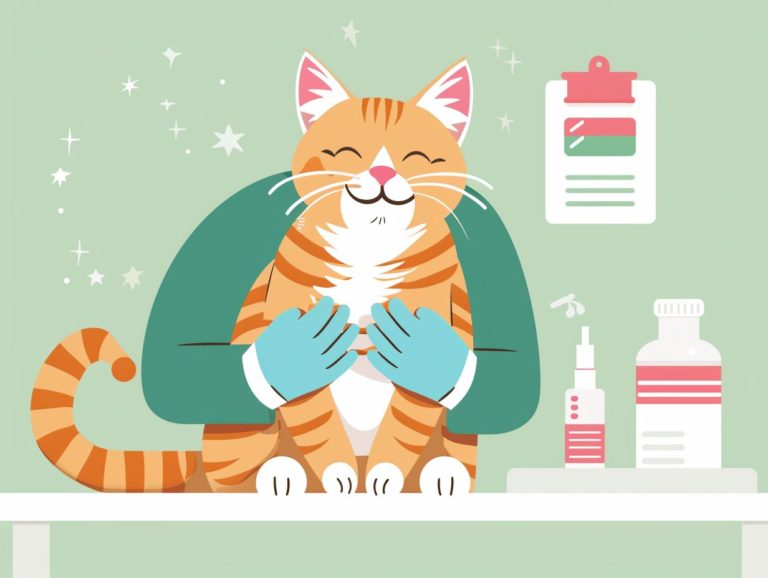The Pros And Cons Of Annual Deductibles In Cat Insurance
Annual deductibles are a key feature of cat insurance that pet owners can consider for their cats, and they hold significant importance. This article explores the definition of annual deductibles, their advantages and disadvantages, and provides guidance on selecting them for cat insurance policies.
Whether the aim is to lower expenses or enhance coverage for one’s pet, having a good grasp of annual deductibles is crucial when making a decision.
Key Takeaways:
Understanding Annual Deductibles in Cat Insurance
Understanding annual deductibles in cat insurance is crucial for cat owners to grasp the financial aspects of their pet’s health coverage. An annual deductible in pet insurance represents the portion of covered veterinary costs that a pet owner must personally cover before the insurance provider starts to reimburse for veterinary expenses.
This means that if a covered cat needs medical treatment, the policyholder must cover the initial costs up to the annual deductible before insurance coverage kicks in. Different pet insurance plans offer a range of deductible options, allowing cat owners to strike a balance between monthly costs and out-of-pocket expenses.
Opting for a higher deductible typically results in lower monthly premiums. Therefore, selecting a policy with the appropriate deductible for cat insurance coverage necessitates consideration of both the cat’s potential medical needs and the owner’s financial situation.
What Are Annual Deductibles?
In pet insurance, annual deductibles are a fixed amount that policyholders must pay each year before the insurer begins covering veterinary expenses. The deductible is a component of the pet insurance policy selected by the pet owner, based on their chosen coverage plan. This deductible plays a significant role in determining both the overall cost and the extent of coverage provided by the insurance policy.
Typically, opting for a higher deductible amount leads to lower monthly premiums, but may result in higher out-of-pocket costs when the pet requires medical treatment. Choosing a higher deductible lowers the monthly insurance premium but increases costs at the time of treatment, while selecting a lower deductible raises monthly premiums but reduces upfront costs during treatment.
The Pros of Annual Deductibles
Annual deductibles in pet insurance offer several advantages, including potential cost savings for the insured and the flexibility to customize coverage based on the insured’s financial situation. Pet insurance companies offer various deductible options, allowing pet owners to tailor their coverage and benefits. These deductible choices enable pet owners to select a deductible level that suits their budget and determine the reimbursement benefits offered by the insurance policy. Opting for a higher deductible usually results in lower monthly premiums, which can be beneficial for individuals seeking to manage their finances effectively.
Some pet insurance providers offer a range of deductible structures to cater to different needs, enabling insured individuals to choose a plan that meets their specific requirements.
Potential Cost Savings
Opting for a high deductible in pet insurance can lead to cheaper premiums, offering potential savings for pet owners in the long run. By choosing a higher deductible, pet owners can enjoy lower monthly insurance costs. Although this may result in higher initial out-of-pocket expenses when filing a claim, the total premium payments throughout the year can be significantly reduced. The affordability of lower premiums with a high deductible plan enables pet owners to effectively manage their finances, ensuring coverage for unexpected veterinary expenses without exceeding their budget.
This financially wise choice allows pet owners to tailor their insurance coverage to their specific requirements and financial objectives.
Encouraging Responsible Pet Ownership
Annual deductibles in pet insurance promote responsible pet ownership by requiring pet owners to pay a specific amount for veterinary expenses upfront before being able to file a claim. This approach encourages pet owners to actively engage in the financial aspects of their pet’s healthcare by offering them a choice of deductible amounts. This enables them to make informed decisions about which healthcare services are most suitable for their pets based on their medical needs and financial situation.
The shared responsibility in selecting deductible options enables pet owners to customize their pet insurance coverage according to their individual circumstances, fostering a sense of accountability and dedication to their pet’s well-being. By involving pet owners in contributing financially to their pet’s healthcare costs, annual deductibles promote financial responsibility and strengthen the bond between a pet owner and their pet.
The Cons of Annual Deductibles
One of the drawbacks of annual deductibles in pet insurance is that they can pose a potential financial burden by offering limited coverage for chronic conditions. Some veterinary expenses may not receive full coverage under policies with annual deductibles. Pet owners whose pets experience ongoing health issues such as diabetes, arthritis, or allergies are particularly impacted by this limitation.
These chronic conditions often necessitate continuous treatment and management, and the resulting recurring expenses may not be adequately addressed by insurance plans with annual deductibles. Consequently, pet owners may find themselves responsible for a significant portion of the costs, impacting their financial stability and potentially leading to difficult decisions regarding their pets’ care.
Potential Financial Burden
The potential financial burden of annual deductibles in pet insurance arises when pet owners face unexpected high veterinary expenses that surpass their deductible amount, leading to financial strain and potentially limiting their ability to provide necessary care for their pets.
The unpredictability of when these high expenses might occur adds to the stress and financial pressure experienced by pet owners. Having to pay the deductible amount upfront before insurance coverage can take effect also poses financial challenges for those with limited budgets.
In such circumstances, pet owners may find themselves in the difficult position of having to choose between their pet’s well-being and their own financial security. This underscores the importance of comprehending pet insurance policy terms and preparing for potential financial obstacles in advance.
Limited Coverage for Chronic Conditions
Typically, annual deductibles result in limited coverage for chronic conditions because many plans restrict reimbursement percentages for these types of health problems. Pet owners need to understand their insurance deductible because a higher annual deductible may lead to a larger out-of-pocket expense before the insurance begins covering the costs of treatments related to chronic conditions.
Policies with lower deductibles usually offer better coverage for ongoing health issues, but they also come with higher monthly premiums. Pet owners must select a deductible amount and monthly premium that guarantees they have sufficient coverage for their pets’ chronic conditions.
Choosing the Right Deductible for Your Cat Insurance
Selecting the appropriate deductible for your cat insurance involves considering your cat’s medical requirements, your financial circumstances, and the deductible choices offered by the insurance provider. Pet owners should review various cat insurance policies with different deductibles to determine the optimal coverage level for their pet’s needs.
By assessing your cat’s overall health and identifying any pre-existing conditions, you can establish the necessary coverage level. The ideal deductible should be affordable within your monthly budget while offering sufficient protection for your cat.
Since different cat insurance companies present varying deductible options, evaluating their policies will assist you in finding the most suitable one for your financial situation and your cat’s healthcare needs. Opting for the right deductible in your cat insurance policy ensures that you can afford high-quality care for your cat without facing financial difficulties.
Factors to Consider
Determining the ideal deductible for cat insurance involves considering factors such as the available deductible options, co-insurance levels, and the overall cost of the policy. Understanding these variables enables pet owners to make informed decisions.
It is crucial to assess the deductible options offered by different pet insurance companies, as deductible levels can vary significantly. Finding a deductible that aligns with your financial situation and risk tolerance is essential. Evaluating co-insurance levels is also important, as this determines the percentage of costs you will be responsible for after meeting the deductible.
Balancing the deductible amount with the co-insurance level can significantly impact your monthly premiums. A comprehensive evaluation of policy costs, including the deductible, co-insurance, premium, and coverage limits, is necessary to choose a policy that meets your pet’s medical needs and fits within your financial budget.
Alternatives to Annual Deductibles
Pet insurance companies not only offer annual deductibles but also provide per-incident deductibles, which are applied to each new health issue that arises. These deductible options offer pet owners more flexibility in managing their pet’s medical expenses. Per-incident deductibles are especially beneficial for pet owners whose pets may experience multiple health issues in a year, as a new deductible is initiated for each distinct incident. If your pet develops different health problems at various times throughout the year, you only need to meet the deductible once per new issue, rather than multiple times. This can lead to cost savings for some pets compared to a single annual deductible, especially for pets requiring frequent veterinary visits or with chronic conditions.
Other Types of Deductibles in Pet Insurance
Pet insurance may include annual and per-incident deductibles, as well as deductibles specific to accident coverage or wellness care. Understanding these deductible variations is important for pet owners assessing their policy terms.
An accident coverage deductible would be applicable each time your pet requires treatment for an accidental injury, such as a broken bone or ingestion of a foreign object. On the other hand, deductibles for wellness care typically apply to routine check-ups, vaccinations, or preventive treatments.
Information on these deductibles and how they impact out-of-pocket costs can be found in pet insurance FAQs. By familiarizing themselves with deductible options, pet owners can make more informed decisions regarding their pet’s health insurance.
Frequently Asked Questions
What are the pros of having an annual deductible in cat insurance?
Having an annual deductible in cat insurance can help lower the overall cost of your premium. This means you pay less each month, which can be helpful for budget-conscious cat owners.
What are the cons of having an annual deductible in cat insurance?
The main con of having an annual deductible in cat insurance is that you will have to pay a certain amount out of pocket before your insurance coverage kicks in. This can be challenging for some cat owners who may not have the funds readily available.
Are there different types of annual deductibles in cat insurance?
Yes, there are typically two types of annual deductibles in cat insurance: per-incident and annual. A per-incident deductible means you pay a set amount for each individual incident, while an annual deductible requires you to reach a certain amount in deductible payments before your coverage applies.
What factors should I consider when choosing an annual deductible for my cat insurance?
When choosing an annual deductible for your cat insurance, consider your cat’s overall health and any pre-existing conditions. Also, think about how much you can afford to pay out of pocket in the event of an emergency or illness.
Can I change my annual deductible amount after I’ve already enrolled in cat insurance?
Yes, you can typically change your annual deductible amount in cat insurance during your policy’s renewal period. Just be aware that changing your deductible may also affect your premium and coverage levels.
Is an annual deductible the only cost I have to worry about in cat insurance?
No, an annual deductible is just one of the costs to consider in cat insurance. You may also have to pay co-pays, which are a set percentage of the total cost of veterinary care, and possibly coinsurance, which is a percentage of the total cost that you are responsible for.



